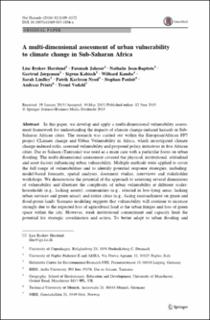| dc.description.abstract | In this paper, we develop and apply a multi-dimensional vulnerability assessment framework for understanding the impacts of climate change-induced hazards in Sub-Saharan African cities. The research was carried out within the European/African FP7 project CLimate change and Urban Vulnerability in Africa, which investigated climate change-induced risks, assessed vulnerability and proposed policy initiatives in five African cities. Dar es Salaam (Tanzania) was used as a main case with a particular focus on urban flooding. The multi-dimensional assessment covered the physical, institutional, attitudinal and asset factors influencing urban vulnerability. Multiple methods were applied to cover the full range of vulnerabilities and to identify potential response strategies, including: model-based forecasts, spatial analyses, document studies, interviews and stakeholder workshops. We demonstrate the potential of the approach to assessing several dimensions of vulnerability and illustrate the complexity of urban vulnerability at different scales: households (e.g., lacking assets); communities (e.g., situated in low-lying areas, lacking urban services and green areas); and entire cities (e.g., facing encroachment on green and flood-prone land). Scenario modeling suggests that vulnerability will continue to increase strongly due to the expected loss of agricultural land at the urban fringes and loss of green space within the city. However, weak institutional commitment and capacity limit the potential for strategic coordination and action. To better adapt to urban flooding and thereby reduce vulnerability and build resilience, we suggest working across dimensions and scales, integrating climate change issues in city-level plans and strategies and enabling local actions to initiate a ‘learning-by-doing’ process of adaptation. | en_US |

